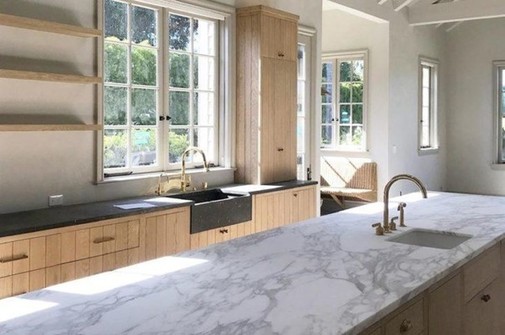When you want to renovate your kitchen or bathroom, one of the options available to you to revamp the room is the choice of a countertop. There are several models on the market. Additionally, the finishes and edges offered are numerous, allowing you to easily choose what suits your vision and project best. The finishes generally depend on the type of countertop chosen. As for the edges, they depend on your preference.
Handmade Finishes
Some materials used in making a countertop require handmade finishes. This finish is done during the renovation and installation of the countertop or as part of its maintenance. For a wooden countertop, for example, possible finishes are varnish and oil (usually natural). For a Corian countertop, the finish can be glossy, satin, or glossy and is obtained by sanding it with grains ranging from 120 to 1200. Typically, natural stone (quartz, granite, marble) or concrete countertops have specific finishes offered by the manufacturer.
Quartz Countertops Finishes
Quartz is a frequently used material in countertop design. It is durable, easy to maintain, hygienic, and eco-friendly. Several finishes are available to customers, like those offered by [Caesarstone](https://www.caesarstone.ca/fr/caracteristiques-et-design/), for example. There is the natural finish which involves slightly texturing the surface to retain the natural color of the stone. This finish slightly reflects light and adopts dark shades. Next, there is the polished finish. It enhances the surface features while making it radiant. The shine has a natural effect. There is also the matte finish, which is both soft to the touch and aesthetic. The quartz countertop can also adopt a concrete finish with a grainy feel to the touch. Finally, there is the raw finish, which offers a unique tactile feel. The surface is slightly rough but smooth enough to facilitate cleaning.
Finishes for Granite and Marble Countertops
For a granite or marble countertop, there are also several finish options. There is the polished gloss. It provides a mirror effect. The colors used are vivid but still reflect stone characteristics. This finish allows for easy cleaning. It also ensures the countertop’s longevity as it prevents moisture infiltration inside. Next, there is the matte softened finish. It provides a very smooth countertop but without a glossy or reflective effect. Then there’s the leather or brushed finish. It’s a new technique that allows for a soft yet sophisticated countertop. The countertop will retain its natural color. This finish has the advantage of hiding all stains, including fingerprints. Then there is the flamed finish, only offered for granite countertops. It is generally intended for indoor countertops. To obtain this finish, manufacturers heat the stone to a very high temperature. The colors then change. The surface becomes rough, adopting a natural appearance. There is also the honed finish, achieved by combining a leather finish with gloss. It is a finish that seals the pores, protecting the countertop from moisture and making it more robust and elegant at the same time. Finally, there is an uncommon but still original finish. It is the hammered finish. It involves hammering the surface to alter it. This finish also offers a look with lightened colors.
Concrete Finishes
Concrete is a material that can be used to make a countertop. It can be mixed with various additives, textures, and others for finishes of choice. The finishes can be matte or glossy depending on the polishing chosen. It is even possible to obtain a highly reflective surface thanks to advanced polishing tools.
Countertop Edges
Beyond the surface finish, the edges are also important. They ensure the countertop’s aesthetics. It is possible to choose an edge that matches the other components of the room (furniture, etc.). Furthermore, the edges also ensure practicality. Choosing one allows for ease when performing tasks in the kitchen or bathroom. There are several edges you can choose from. There is the ogee edge, which is quite original. It’s not just ceilings that can have it; countertops can also adopt this molding as an edge. This edge can appear on the surface or can be inverted and stacked at the base. Then, there are natural edges sometimes called breeze or rock. It’s an unpolished edge that reflects the image of the material in its raw state. The countertop edges are squared. There’s also the double edge. This finish gives the impression of a heavy countertop, though it is not really. There is also the double bevel finish. Like a double-bevel knife, the countertop edges will be sharpened on all sides. Then, there is the rounded finish. There are also double rounded, laminated, triple rounded laminated, or slightly rounded. The edges will thus be round and polished. Finally, there is the mitered finish where the edges form an angle. When choosing edges, several criteria must be considered. If they are exposed edges, for example, they must adopt the same finish as the surface. If the countertop surface is wide, it’s better to opt for rounded edges to avoid chipping. The radius should be at least 3 or 4 mm, but ideally, it’s a radius of 6 mm. This will ensure maximum durability. Regarding thickness, you have various options, but ideally, it’s a countertop whose edge thickness is 6 cm.


